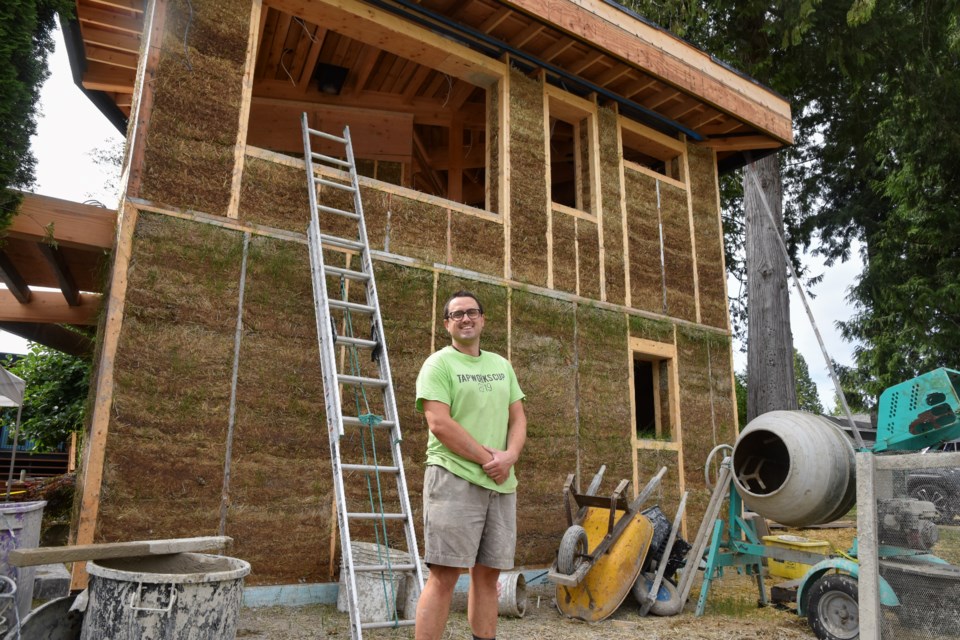A laneway house being built in lower Gibsons has been turning heads as passersby see natural materials such as clay and straw being tamped in as insulation and watch grass growing on the side of the building.
When owners Ryan Leech and Krysta Powers obtained the permits to build the family home, they knew they wanted to “go the eco-build route,” says Tim Vigneux, of contracting company Natural Focus. He adds they are hoping to inspire change in the construction community, to build as ecologically ethically as they can. He jokes that about 10 per cent of their time on the project has been public relations as people walk by.
The build has used as much recycled and reclaimed material as possible, which adds to the identity of the house, he says. But, once the two-storey post-and-beam house is done, it would be hard to believe the walls are packed with natural materials and not conventional insolation, he notes.
Wood has been sourced from far and wide, from storm-downed trees to reused lumber from house deconstructions to bridge timbers from the cast-off pile at the Port Mellon mill.
“We’re not pioneers of the art,” says Vigneux, pointing to eco-building reference books in the work yard and explaining how he and the lead builder on the project, Ben Turner, both transitioned to this line of work relatively recently.
Turner owns Natural Focus and he and Vigneux also operate Coast Pro Deconstruction, which specializes in deconstructing homes and reusing the materials on projects like this one.
Turner, Leech and Vigneux have done much of the work, hiring more people and having “work party days” when more labour is required––like for packing the straw-clay into the wall.
While this style of building may be considerably cheaper than traditional builds, the costs add up in different ways, such as manual labour. “It's very laborious in terms of the number of arms and bodies that you need to do this.”
The straw was sourced from Abbotsford and a local contracting company gave the clay for free.
Making the mixture is a lengthy process. Once the straw is separated and in the mixer, clay is shovelled into a container and mixed with water to the right consistency.
The mixture is then sifted and poured into the mixer with the straw. The team then separates the mixture into buckets and carries the buckets up ladders to the second floor.
“It's a lengthy process but honestly, you get into a flow, it's pretty straightforward,” Vigneux says. “This is not new technology, it's just a modern take on old technology.”
Vigneux says one of the main reasons he loves the project is how approachable it is to so many people. “You can just hand somebody a tamper, hand them a bucket of straw-clay and [they can] go to town on it, with supervision, of course.”
He says the straw-clay works great with the truss wall construction style because it packs down well, is very dense, is difficult ingress for rodents, and is highly fire resistant. Bamboo is also used as a rebar throughout the home.
Throughout the process local contractors have been integral, having worked on similar projects before.
The home will feature a “truth window,” a popular feature of eco-homes, where a window within the home opens to expose the wall interior, proving its eco-origins.
The walls take about two months to dry, which Vigneux says is one of the downsides of building with straw-clay, given coastal B.C.’s relatively short dry season.
While almost all the Gibsons project’s materials were reclaimed or repurposed, some things had to be bought new, such as fasteners and the occasional sheet of plywood, as well as the spray foam roof insulation (to prevent air gaps).
The foundation was poured in late 2023, with construction beginning in March, and, conservatively, is expected to wrap up early in 2025, says Vigneux. There’s still a lot left to do, such as plastering the house once the straw clay dries. “The goal is to use materials where we can, buy materials where we have to, but otherwise, try to do this as ecologically ethically as we can.”
Jordan Copp is the Coast Reporter’s civic and Indigenous affairs reporter. This reporting beat is made possible by the Local Journalism Initiative.



